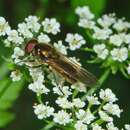en
names in breadcrumbs


Cheilosia latifrons is a species of 'Flower Flies' or hoverflies belonging to the family Syrphidae subfamily Eristalinae.[1] [2] [3] [4][5][6]
This species is present in most of Europe, in the eastern Palearctic realm to Siberia, in the Near East, and in North Africa.
The adults grow up to 6–9 millimetres (0.24–0.35 in) long and can mainly be encountered in meadows from May (March in South Europe) through September (with peaks in June or July and September), unimproved, non-calcareous grassland, usually on poorly drained sites and also coastal dune systems. It is low-flying, at the level of grasses and other low plants, among which it settles. Flowers visited include yellow Compositae, especially Senecio and Taraxacum; Origanum, Ranunculus, Luzula and Plantago.[7]
The body is glossy black, with yellowish hair. Legs are yellow with a broad, black ring in the middle and the tarsi are dark. The scutellum is without obvious bristly hairs at margin, the antennae are black or partly or entirely dark reddish. The thorax is finely punctate.
The larvae probably develop in roots and stems of Leontodon autumnalis and Crepis species.
Cheilosia latifrons is a species of 'Flower Flies' or hoverflies belonging to the family Syrphidae subfamily Eristalinae.
This species is present in most of Europe, in the eastern Palearctic realm to Siberia, in the Near East, and in North Africa.
 Habitat.Ireland.
Habitat.Ireland. The adults grow up to 6–9 millimetres (0.24–0.35 in) long and can mainly be encountered in meadows from May (March in South Europe) through September (with peaks in June or July and September), unimproved, non-calcareous grassland, usually on poorly drained sites and also coastal dune systems. It is low-flying, at the level of grasses and other low plants, among which it settles. Flowers visited include yellow Compositae, especially Senecio and Taraxacum; Origanum, Ranunculus, Luzula and Plantago.
The body is glossy black, with yellowish hair. Legs are yellow with a broad, black ring in the middle and the tarsi are dark. The scutellum is without obvious bristly hairs at margin, the antennae are black or partly or entirely dark reddish. The thorax is finely punctate.
The larvae probably develop in roots and stems of Leontodon autumnalis and Crepis species.
Cheilosia latifrons es una especie de sírfido. Se distribuyen por el paleártico en Eurasia y África del Norte.
Cheilosia latifrons es una especie de sírfido. Se distribuyen por el paleártico en Eurasia y África del Norte.
Het bruin gitje (Cheilosia latifrons) is een vliegensoort uit de familie van de zweefvliegen (Syrphidae).[1] De wetenschappelijke naam van de soort is voor het eerst geldig gepubliceerd in 1843 door Zetterstedt.
Bronnen, noten en/of referenties
Breipannet urteblomsterflue (Cheilosia latifrons) er en middelstor flue som tilhører familien blomsterfluene. Den finnes over hele Norge.
En middelsstor (6-9 mm), helsvart blomsterflue. Antennene varierer i farge fra gulrøde til mørkbrune. Fasettøynene er sparsomt hårete hos hannen men nakne hos hunnen. Det avgrensede området langs forkanten av fasettøynene (øyelistene) er uvanlig bredt, bredere en forleggens bredde. Kroppen er blankt svart, med mest gulaktige hår. Scutellum mangler børster langs kanten og mørke hår. Lårene er svarte med gul spiss, leggene gule med en bred, svart ring i midten, føttene mørke. Vingene er litt brunt røykfargede.
Denne arten påtreffes helst på kalkholdige enger. Larvene utvikler seg trolig ved rothalsen på følblom (Leontodon autumnalis). De voksne fluene flyr i mai-september.
Arten er utbredt i Palearktis vestover til det vestlige Sibir, også over hele Norge.
Breipannet urteblomsterflue (Cheilosia latifrons) er en middelstor flue som tilhører familien blomsterfluene. Den finnes over hele Norge.
Cheilosia latifrons là một loài ruồi trong họ Ruồi giả ong (Syrphidae). Loài này được Zetterstedt mô tả khoa học đầu tiên năm 1843. Cheilosia latifrons phân bố ở vùng Cổ Bắc giới (Đan Mạch)[1][2]
Cheilosia latifrons là một loài ruồi trong họ Ruồi giả ong (Syrphidae). Loài này được Zetterstedt mô tả khoa học đầu tiên năm 1843. Cheilosia latifrons phân bố ở vùng Cổ Bắc giới (Đan Mạch)